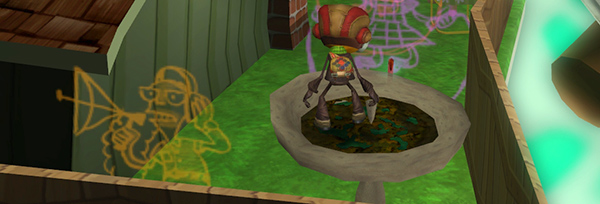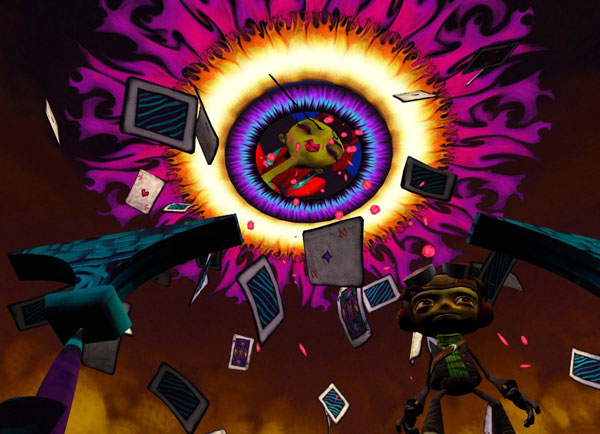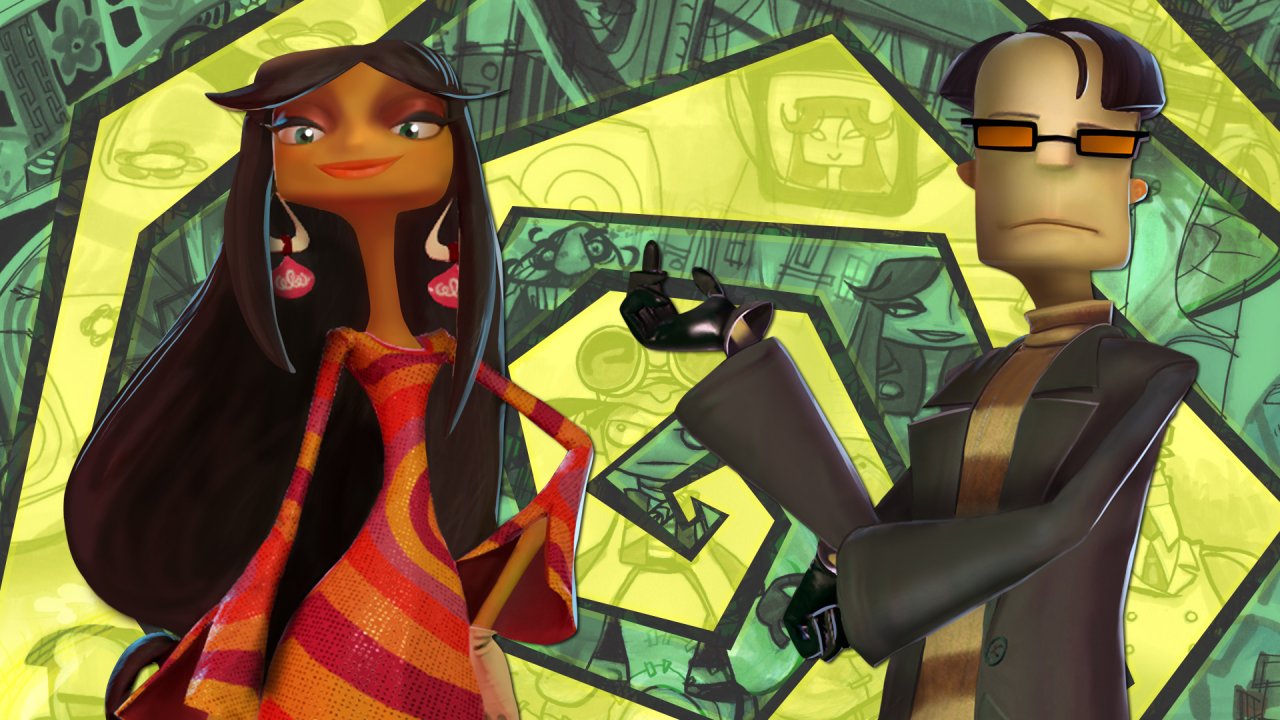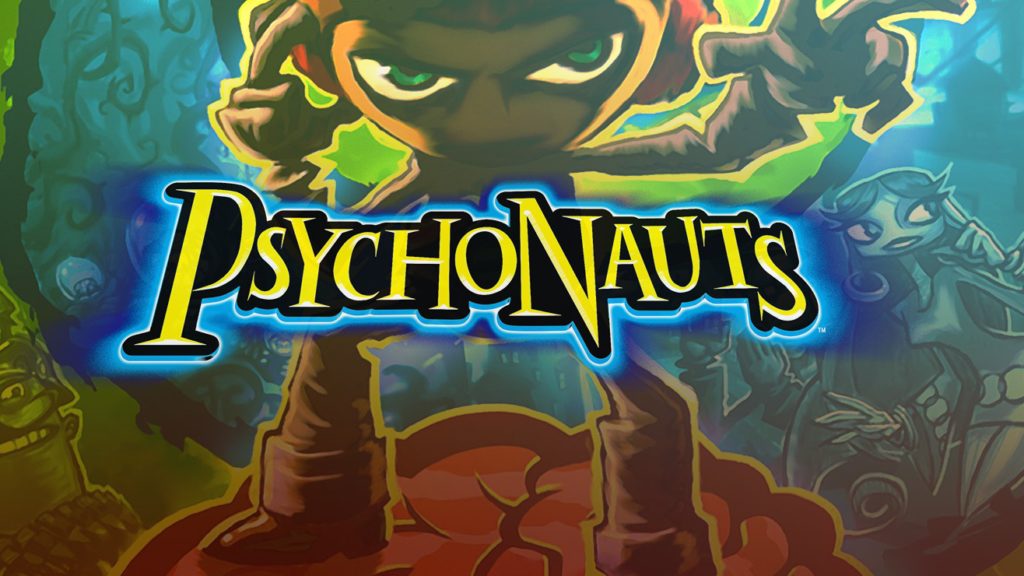*Arrives 12 years late with Starbucks* Hey, have you guys heard about Psychonauts? It’s pretty awesome.
So yeah, I’m extremely late to the game (in more ways than one) when it comes to playing this piece of work from Double Fine. If you’re as behind as I was, I’ll just say you have no idea what you’re missing.
The game takes place in a world where psychic abilities are pretty well acknowledged as A Thing. Thus, especially adept psychics can train up and join an elite squad known as the Psychonauts. In an effort to get on that path, ten-year-old Raz Aquato runs away from home to attend a summer camp for young psychics. As it turns out, he’s extremely adept — which is handy when his fellow campers start literally sneezing their brains out. Gaining merit badges and training with top-tier Psychonauts Sasha Nein and Milla Vodello, Raz uncovers the evil scheme surrounding Whispering Rocks Psychic Summer Camp.
It is … a fun game. Like super fun. Raz is voiced by Richard Horvitz (Zim of Invader Zim), with more familiar voices scattered throughout. Levels take place both in the real world and in the minds of other characters. And late in the game, there are some straight-up clever and gorgeous design choices when it comes to depicting characters’ psyches.
What really got me about it, though, is that the whole game actually works on a psychological level. Which shouldn’t surprise me… if someone’s making a game that takes place more than half inside people’s minds, they’ll need to know their stuff. But there’s so much to explore when it comes to everything from plot points to collectibles. And, rather pleasingly, they’ve gotten it all right. And in a way that can help us understand how our own minds work.
Clever Collectibles

Like any self-respecting game these days, Psychonauts makes heavy use of collectibles. In the minds of other characters you mostly confront four types of items: Figments, Emotional Baggage, Mental Cobwebs, and Memory Vaults. Each serves a different purpose — but a realistic one. In-game they help you rack up skills, but how they work is a clever reflection of their namesakes.
“Figments” are cartoonish, translucent props. You can walk through them and collect them. They won’t hurt you — if anything, clearing them out is a help. Mental Cobwebs require a little more experience before you can tackle them, but they won’t hurt you. Once you can remove them, though, they open the way to new paths through the mind.
Emotional Baggage is a tough one. As you go through a level, you’ll hear crying from somewhere off to the side. Take a look, and you’ll find it’s a hat box or a duffel bag: literal “emotional baggage.” (Get it?) You can get rid of it by sorting through it, but not until you’ve scoured the level for the proper baggage tag. In other words, you can’t sort through your emotional baggage until you’ve got the right tools to tackle that particular one. (Again … get it?)
And finally, there are Memory Vaults. Major characters have two each, and they contain storybooks drawn by the concept artist about an event in the character’s past. Some are essential when it comes to story progression. Others are there for character background, or (in the case of one) to prove that shipping Sasha and Milla is 100% canon. Some are hidden away cleverly on purpose, others simply lost and wandering. But memories are never “lost” — just hidden.
Unreliable Memories

Early levels see Raz going into the minds of Sasha and Milla: two trained Psychonauts who have designed their mental interiors. They can situate things as they like, and even create training groups for PSI Cadets. Later in the game, you hop into the minds of non-psychics. So, going through their psyches should be straightforward and lay everything about them bare, right?
Nothing could be further from the truth.
Let’s take, for example, Black Velvetopia — one of the most visually stunning levels in the game. It’s the mindscape of Edgar Teglee, a patient undergoing “art therapy” in a mental institution. We discover that his condition is situational, caused by the loss of his true love Lampida to a romantic rival. So all we need to do is help him get Lampida back and everything is fine, right?
Well … it’s not that easy.
One thing we learn in the back end of the game is that you don’t have to be a crack psychic to “rewire” your mindscape. If anything, the minds of the untrained are more likely to be inaccurate. They’re overdramatized, biased, and sometimes just straight-up wrong. And these aren’t necessarily things done on purpose. It’s just… how humans are. Teglee’s impression of his situation with Lampida is, to put it lightly, inaccurate. (I won’t say how because you totally need to play this game.) And when you discover this, your job and his needs are at odds. He wants a resolution for his soap opera; you know that he will find resolution once he achieves clarity.
The rest of the institution arc — in fact, even the rest of the game — continues to reflect that. When it comes to situational issues like this, sometimes the help we need isn’t the help we want. Sometimes it’s a matter of acknowledging that our personal mindscape doesn’t necessarily reflect reality, and that that’s not “weird” or “crazy.” It’s just perspective, and it empowers us to help ourselves.
The Training Continues

Psychonauts was the creation of game dev legends Tim Schafer (Monkey Island, Grim Fandango) and Erik Wolpaw (Half-Life 2, Portal). With that pedigree, it’s unsurprising that this game goes full-throttle with its psychological tools and references. No plot or imagery or game functionality is wasted.
And these are just two aspects of the game. If I had more time, I could go on even longer. There’s Ford Cruller, a walking analogy for genius brought down by Alzheimer’s. Or the game mechanic where how others see you affects how they treat you — and once you learn telepathy, you can see that every character, critter, and prop has a different mental image of you. Even those for whom that game mechanic makes no difference.
And I haven’t even touched on Rhombus of Ruin, the VR experience where we enter the mind of the game’s main villain and learn to understand him.
You don’t have to dig deep to enjoy Psychonauts, though. You can float around on levitation bubbles, fight kaiju inside the brain of a giant fish named Linda, and face down pyrokinetic cougars. The art style is wild and fun, and just improves with the VR version. The voices are great, and (as you may have guessed from the writers) so is the dialogue. It’s just fun and weird and surreal and funny.
But the care that’s taken in detailing what our minds do and how that affects everyone around us is, like, crazy genius. It’s so much more than we ever needed. It helps the plot along, and it teaches us a few little lessons of our own along the way. Are people really treating us as we deserve, or just based on their image of us? Are we ready to sort through this emotional baggage, or are we still missing something? What stories are we telling inside our own mind that are preventing us from dealing with our issues?
Seriously, this game is ten bucks on Steam, and you can finish it in a couple of extra-devoted days. And with a new game around the corner, it’s a good time to jump on.
Meanwhile, I gotta go back and ask my friend if she has any good Sasha/Milla fic.


Comments are closed.